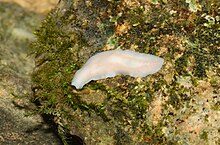Dendrocoelidae is a family of freshwater tricladida flatworms that has a holarctic distribution.[1]
| Dendrocoelidae | |
|---|---|

| |
| Dendrocoelum cavaticum | |
| Scientific classification | |
| Domain: | Eukaryota |
| Kingdom: | Animalia |
| Phylum: | Platyhelminthes |
| Order: | Tricladida |
| Superfamily: | Planarioidea |
| Family: | Dendrocoelidae Hallez, 1892 |
| Genera | |
The largest freshwater triclad known belongs to this family, it's up to 40 cm in length and inhabits the Lake Baikal.[2]
Description
editThe family Dendrocoelidae is characterized by an unusual arrangement of the muscle layers of the pharynx. While in most planarians the inner musculature of the pharynx is composed of two muscle layers, one circular and one longitudinal, in Dendrocoelidae the circular and longitudinal fibers are intermingled, forming a mixed layer.[1]
Dendrocoelidae is the sister group of Kenkiidae. Both families have an anterior adhesive organ, which is considered a synapomorphy of the group.[1]
Genera
editThe following genera are recognised in the family Dendrocoelidae:[3]
- Genus Acromyadenium de Beauchamp, 1931
- Genus Alaoplana Kenk, 1974
- Genus Amyadenium de Beauchamp, 1931
- Genus Anocelis Stimpson, 1857
- Genus Archicotylus Korotneff, 1912
- Genus Armilla Livanov, 1961
- Genus Atria Porfirieva, 1970
- Genus Baikalobia Kenk, 1930
- Genus Baikalocotylus Porfirieva, 1977
- Genus Baikaloplana Berg, 1925
- Genus Bdellocephala de Man, 1875
- Genus Caspioplana Zabusova, 1951
- Genus Dendrocoelopsis Kenk, 1930
- Genus Dendrocoelum Ørsted, 1844
- Genus Hyperbulbina Livanov & Porfirjeva, 1962
- Genus Hyperpapillina Porfirieva, 1973
- Genus Microarchicotylus Porfiriev & Timoshkin, 2015
- Genus Miodendrocoelum de Beauchamp, 1929
- Genus Papilloplana Kenk, 1974
- Genus Polycladodes Steinmann, 1910
- Genus Procotyla Leidy, 1857
- Genus Protocotylus Korotneff, 1908
- Genus Rimacephalus Sabussov, 1901
- Genus Sorocelis Grube, 1872
Phylogeny
editPhylogenetic supertree after Sluys et al., 2009:[4]
References
edit- ^ a b c Sluys, R.; Kawakatsu, M. (2006). "Towards a phylogenetic classification of dendrocoelid freshwater planarians (Platyhelminthes): A morphological and eclectic approach". Journal of Zoological Systematics and Evolutionary Research. 44 (4): 274. doi:10.1111/j.1439-0469.2006.00371.x.
- ^ Kozhov, M. 1963. Lake Baikal and Its Life. The Hague: W. Junk. vii + 344pp.
- ^ "WoRMS - World Register of Marine Species - Dendrocoelidae Hallez, 1892". www.marinespecies.org. Retrieved 2021-10-19.
- ^ Sluys, R.; Kawakatsu, M.; Riutort, M.; Baguñà, J. (2009). "A new higher classification of planarian flatworms (Platyhelminthes, Tricladida)". Journal of Natural History. 43 (29–30): 1763–1777. doi:10.1080/00222930902741669.